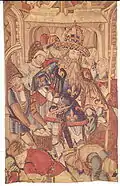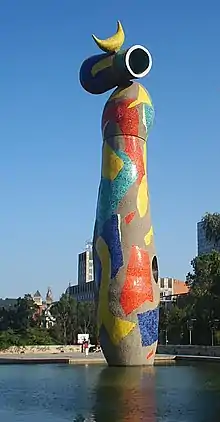| The World Trade Center Tapestry | |
|---|---|
| Catalan: Gran Tapís del World Trade Center | |
 | |
| Artist | Joan Miró, Josep Royo |
| Year | 1974 |
| Type | Wool and hemp |
| Dimensions | 6.1 m × 11 m (20 ft × 35 ft) |
| Condition | destroyed in 2001 |
The World Trade Center Tapestry was a large tapestry by Joan Miró and Josep Royo. It was displayed in the lobby of 2 World Trade Center (the South Tower) in New York City from 1974 until it was destroyed in 2001 by the collapse of the World Trade Center.
Saul Wenegrat, former director of the art program for the Port Authority of New York, had suggested to Miró that he could make a tapestry for the World Trade Center, but the artist declined as he would only make the work with his own hands but had no experience of making a tapestry. However, after his daughter recovered from an accident in Spain, Miró agreed to make a tapestry for the hospital that had treated her as a token of his gratitude. Having learned the technique from tapestry maker Josep Royo, Miró made several other tapestries with Royo, including one for the World Trade Center, Woman for the National Gallery of Art in Washington, DC, and one for the Fundació Joan Miró.
The work was an abstract design, with bright blocks of colour, red, green, blue and yellow, with black elements and a light brown background. Made of wool and hemp, it measured 20 × 35 feet (6.1 × 10.7 m) and weighed 4 tons. It was completed in 1973, and displayed at a retrospective at the Grand Palais in Paris before being installed in New York City in 1974.
See also
References
- Tozzoli, Guy F. (May 25, 1981). "Taking Care Of the Trade Center's Miro Tapestry". The New York Times. p. A14.
External links
- World Trade Center Tapestry, Joan Miró
- Woman 1977, National Gallery of Art
- Tapestry of the Foundation, Joan Miró, 1979, Fundació Joan Miró
- Public Art at the World Trade Center, Saul Wenegrat, Proceedings of an IFAR Symposium on February 28, 2002

